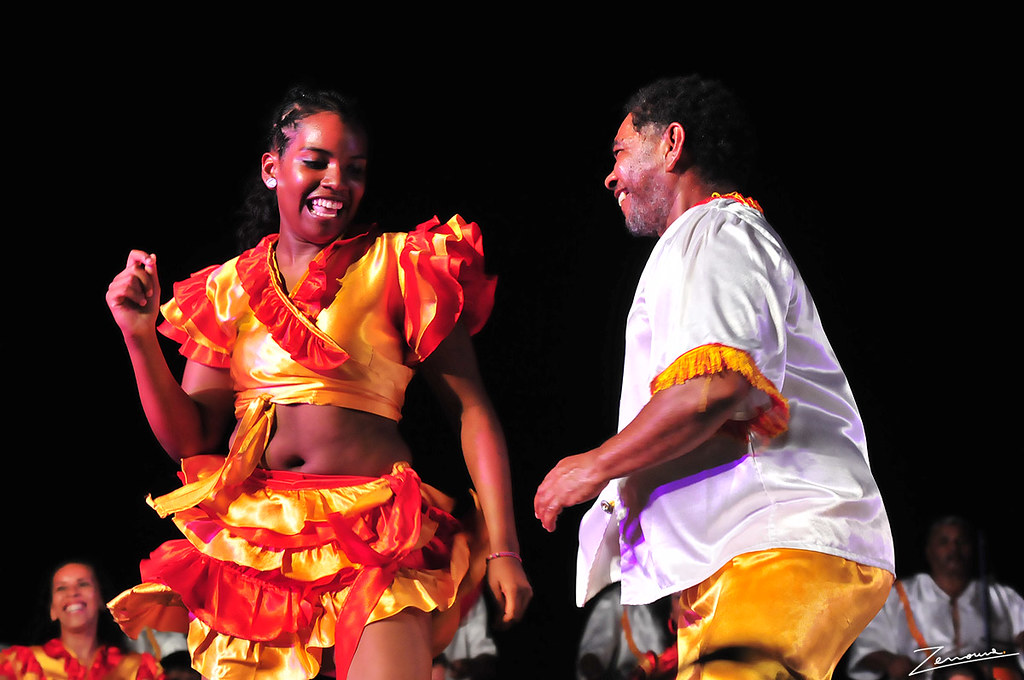
Afro-Paraguayan dancers of Kamba Kue. En los bailes del grupo Kamba Cua no faltaron sonrisas ni alegría, contagiaba y llenaba el alma de felicidad. (In the dances of Kamba Cua group, they weren't short at all with smiles or joy, that spread and filled the soul with happiness.)
In the first decade of the 21st century the notion that Paraguay has no Black population still
persists, despite the widely acclaimed Afro-Paraguayan dance group Ballet Kamba Cuá, which
gives performances across the country and in neighboring countries, and whose celebration of St.
Balthasar on January 6 attracts spectators from around the nation.
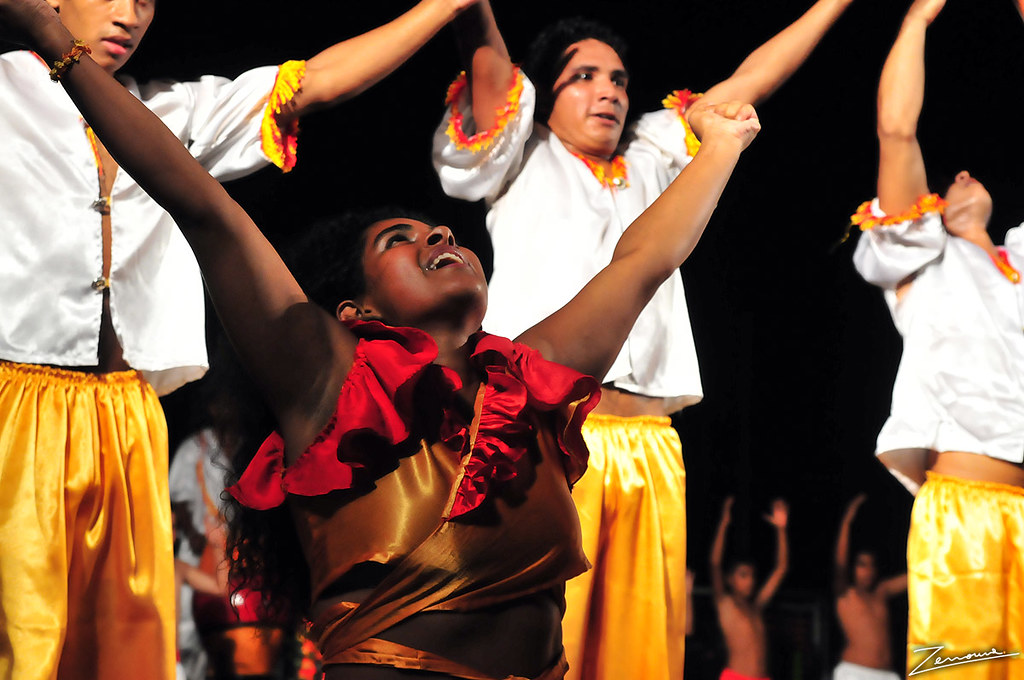
Afro-Paraguayans
Some historians believe that the “neo-Africanization” of Camba Cua, and by extension Kamba Kokué and Emboscada, presents unquestionably a positive development for Paraguay’s afrodescendientes. To date the essence of Camba Cua culture is identified with drumming and the accompanying dance, while in Kamba Kokue and Emboscada only vague notions of a “Black” past form a common thread of identity, only recently supplemented by the activism of a handful of intellectuals. No element of language is associated with Afro-Paraguayan self-identity, with the exception of a lullaby thought to be in an African language which some Camba Cua community members assert has been part of the traditional culture, but which appears to have been taught by a visiting African artist.

Lázaro Medina, Afro-Paraguayan and Director of the Ballet Camba Cua.
It must be noted that apart from Argentina that espouses itself as completely "White" and systematically targeted blacks for extermination, Paraguay is another southern American country that has successfully exterminated blacks (people of African descents) whose population in 1800 used to be around 11,000 or nearly 11% of the national total population to be drastically reduced to only 2% as at 2014. It must also be emphasized that in 1782, the black population represented 11.2 percent of the total population. In 1811 half of the Paraguayan population was of African descent. Also, curiously, people of ethnic Kamba Cuá, a Kenyan ethnic group out of Uruguay, came to settle in Paraguay in the 1820s. They arrived in a regiment of 250 spearmen, men and women, who accompanied General Jose Gervasio Artigas, the revolutionary leader of the now nation of Uruguay, in his exile to Paraguay.
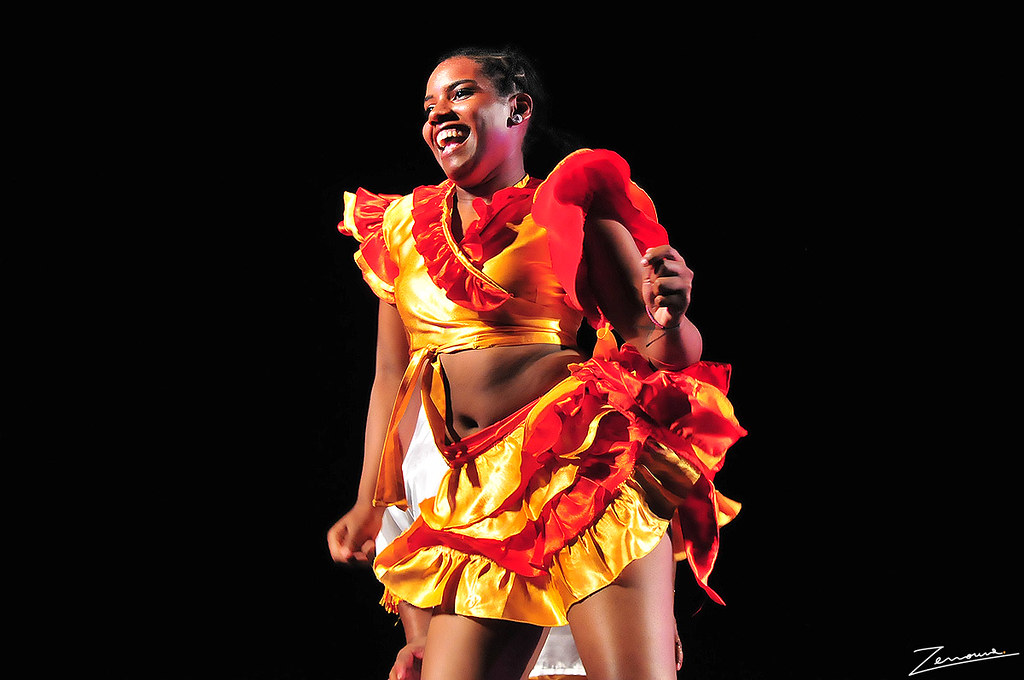
Afro-Paraguayan female dancer
Paraguay was the last port of arrival of African slaves in Americas, and they, mostly of Angolan, Nigerian and Kenyan origin. The first batch of African slaves arrived in Paraguay in 1556. The blacks were mostly Yoruba people from Nigeria, Kongo (Ambundu, Umbundu etc) people from Angola and Kamba people from Kenya. The Afro-Paraguayans (Afroparaguanyos) who are also known as "pardos" were concentrated in three communities in the Eastern region of the country. They are the Kamba Cuá, Kamba Kokue (meaning "chacra de negros"- black farm in Guarani language), and Emboscada.

Afro-Paraguayan dancers from Kamba Kue Community (Grupo de dança da comunidade afrodescendente Kamba Kuá.)
Today, be black in Paraguay is to be almost invisible to the rest of society. Most Paraguayans are unaware of the existence of a black community in Paraguay and assume that any black people are Brazilian. Nevertheless, Afro-Paraguayans, despite their lack of numbers and the daily racism to which they are subjected, maintain a distinct identity characterized by a vibrant and continually evolving culture.
In fact, Cambacuá, an Afro-Paraguayan community of 300 families (c. 2,000 individuals) located some 15 km to the east of the Paraguayan capital Asunción in the municipality of Fernando de la Mora, has been violently dispossessed of over 90 per cent of its land by the Paraguayan state for over 30 years.
Afro- Paraguayans are not included as a separate category within the national census and their exact numbers are unknown; however, They are added along with the indigenous population to comprise 2 percent of the population they government statistic claims. They are among the most impoverished groups in the country. While the Paraguayan Constitution recognizes the existence of indigenous people – and guarantees them the right to land and the freedom to practise their distinct
cultures – Afro-Paraguayans as a separate category are absent from any national legislation, as if it were assumed that black culture either has disappeared, or should do so.
Since then, in the face of human rights abuses, immense poverty and racial discrimination, the Afro-Paraguayan communities led by its leading advocacy group La comunidad Afro Paraguaya Kamba Kua has been immersed in a struggle both to retain its identity and to have its traditional land restored.

Afro-Paraguayan dancers
Demography
Ethnically, culturally, and socially, Paraguay is touted as one of the most homogeneous populations in South America. About 95% of the people are mestizo (mixed Spanish and Guaraní Indian descent. Little trace is left of the original Guaraní culture except the language, which is spoken by 90% of the population. About 75% of all Paraguayans also speak Spanish. Guaraní and Spanish are official languages.
This assertion that Paraguay has the most homogeneous population cannot be true. Because Paraguay has a history of other settlement especially in the 20th century: Germans, the majority are Mennonites with long-reigned dictator Alfredo Stroessner himself of German ancestry, Japanese with Okinawans, Koreans, ethnic Chinese, Arabs, Ukrainians, Southern Europeans, Brazilians, and Argentines are among those who have settled in Paraguay. There are also an estimated 63,000 Afro-Paraguayans, or 1% of the population.
Historically the whites were not more than the blacks in Paraguay. Colonial Paraguay imported few enslaved Africans, due to the unique conditions of this colony, and those who did arrive more frequently came from Buenos Aires or Brazil than directly from Africa.i An estimate of the population in 1682 suggested some 6% of the total population was Black, with the proportion rising to 11% in Asunción (Argüello Martínez 1999:69; Pla 1972; Boccia Romañach 2004; Williams 1974).
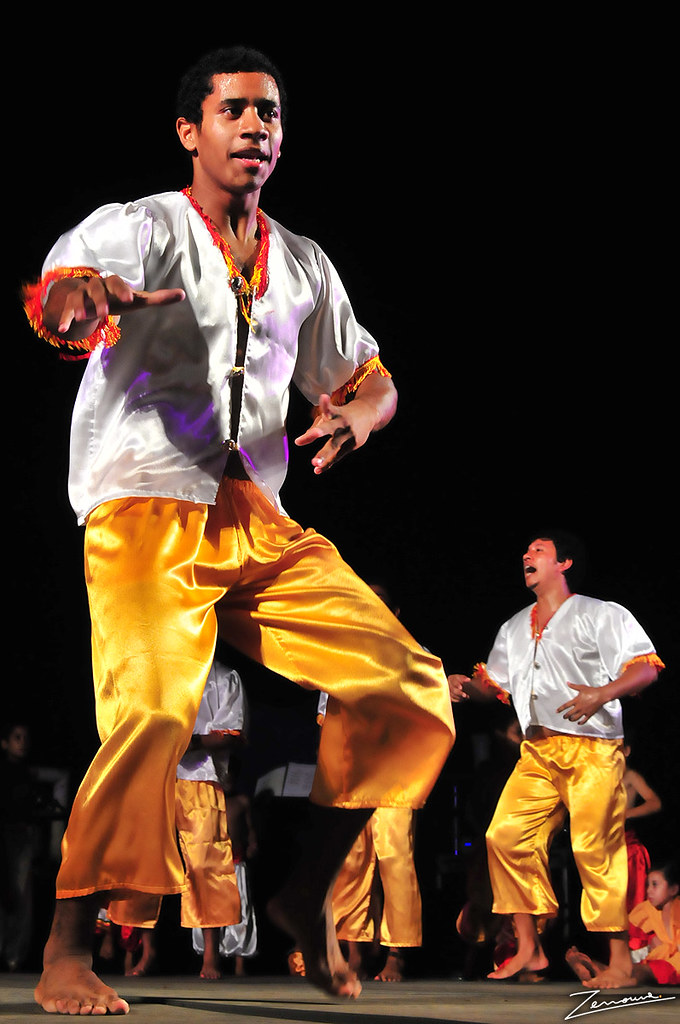
Afro-Paraguayan man from Kamba Kue dancing group
In 1800 the free and captive Black population was some 11,000 or nearly 11% of the total national total. When one considers that another 31% of the population was indigenous—including many not participating in the Spanish colonial culture—the proportion of Blacks to whites rises to nearly 18% (Andrews 2004:41). A census of young people (age 11-16) Asunción taken in 1854 revealed 385 white children and 294 pardos (Black and mulatto) children (Pla 1972:33).
A count of Blacks and mulattoes taken in 1782 revealed a total of 10,838 Black enslaved and free citizens (Pla 1972:36). In the 1860’s it was estimated that at least 10% of Paraguay’s population was Black or mulatto (Pla 1972:37; 1976:206). In 1925 there was an estimate of some 10,000 Paraguayans of noticeable African descent,, another estimate of 31,500 in 1935, and as late as 1951 an informal estimate of 3.5% of the national population was presumed to have some African blood (Rout 1976:208). Oviedo (1992) extended this estimate into the 1990’s, and this figure was incorporated into the map in Minority Rights Group (1995: xiii). As a little-known facet of Afro-Paraguayan history, during the dictatorship of Dr. Gaspar Rodríguez de Francia (1814-1840), known as El Supremo 'the Supreme one,’ Francia decreed that white citizens could not marry other whites, but could only marry Blacks, mulattoes, or Indians (Williams 1971:272); to the extent that this law was actually enforced (and Williams’ sources suggest that it was), racial mixture was further accelerated in a nation whose colonial origins already stemmed from an atypical demographic mix: Spanish men (mostly soldiers), and Native American women.
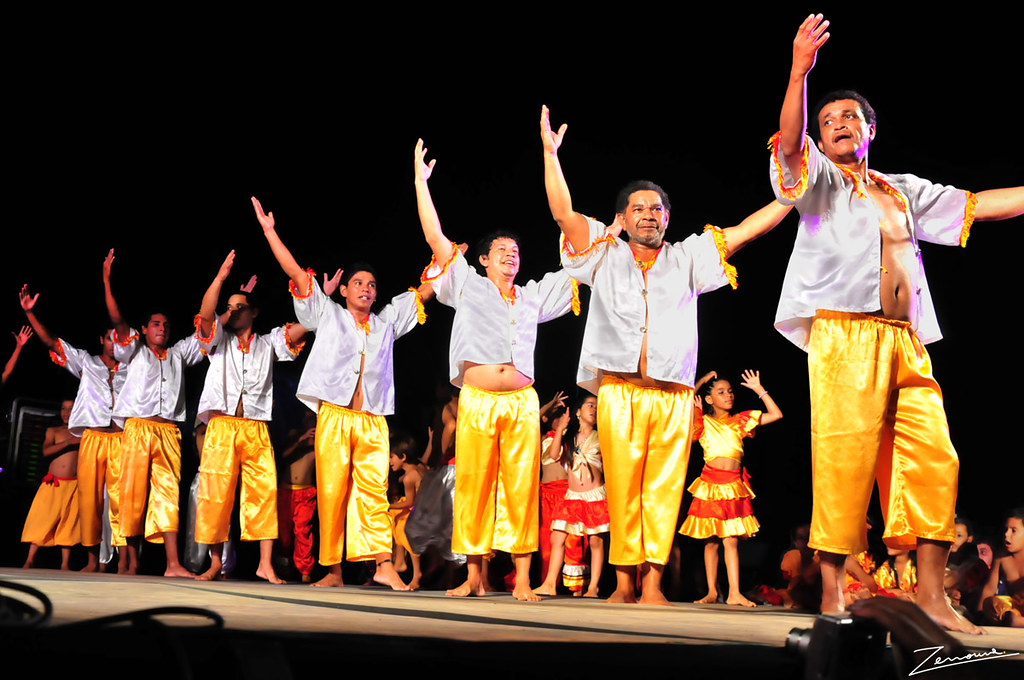
Afro-Paraguayan dancers
Language
The history of the Afro-Paraguayan communities is one of isolation and discrimination, coupled
with a traditionally strong sense of ethnic identity. These are precisely the conditions that favor
the retention of ethnolinguistic traits apart from the speech of the surrounding non-Afro
descendent Paraguayan towns, as has occurred in some other Afro-Hispanic communities
throughout Latin America. An obvious source of such potential differentiating features would be
the partially restructured Spanish first acquired as a second language by African-born bozales
during the colonial period; in some instances traces remained in subsequent generations of Afrodescendents born in the colonies and acquiring some variety of Spanish as a native language.
In view of the de facto ghettoization of Afro-Paraguayans, especially in Camba Cua, Laurelty, and
Kamba Kokué, some innovations may have arisen that are not directly traceable to earlier Afro-
Hispanic speech patterns. To date Paraguay has never been included in the search for remnants
of Afro-Hispanic language, and there are no documents—not even literary parodies or folkloric
texts—to give testimony to Africans’ approximations to Spanish during earlier time periods; the
only fragment uncovered so far is a legal document dated 1789, which offers a brief fragment in
pidginized Spanish attributed to an African (Argüello Martínez 1999: 95): ¡Sargento! ¡No haber
de llevar! [Sergeant, not take {me}!].
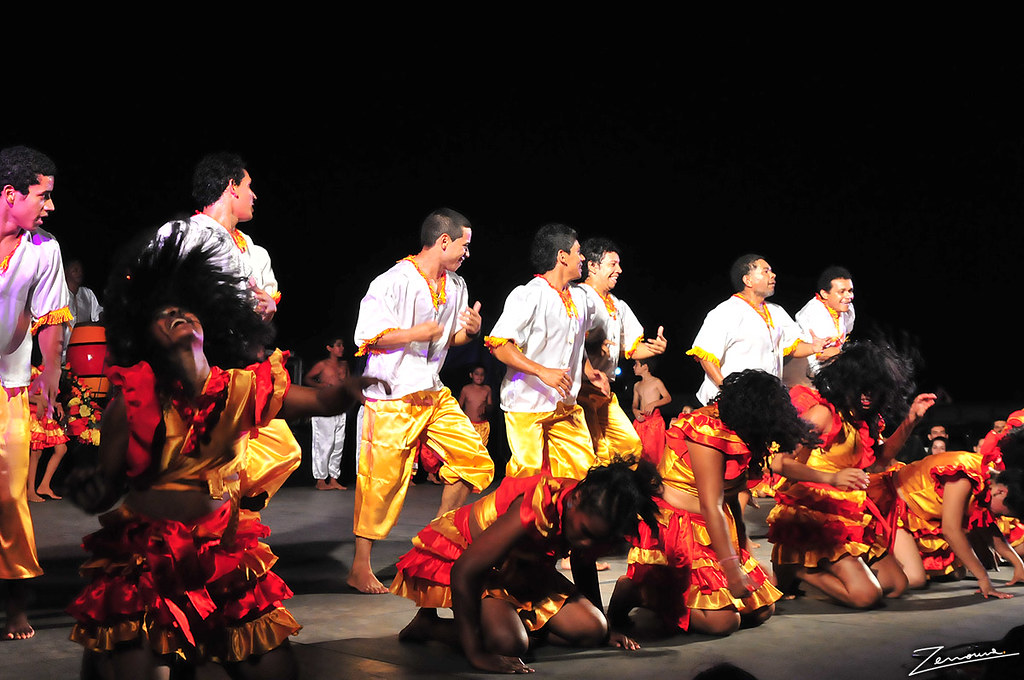
Lapses of Noun-adjective Gender Agreement
Afro-Paraguayan speech in the three small enclaves exhibits several instances of lack of the
usual adjective-noun agreement for grammatical gender (masculine-feminine), which is
obligatory and exceptionless in Spanish. As with other Afro-Hispanic dialects, the masculine
gender usually predominates, but cases like la motivo `the motive’ occasionally occur.
Camba Cua:
la [el] motivo é ... {the motive is}; é jodido [jodida] la cosa que tiene ... {the thing that he has is
screwed up} ; loh [las] mujere {the women}; todo [todas] mih cosa [all my things]; algún
[alguna] comida {some food}; esas oracione legítimo [legítimas]que han traído {those legitimate
prayers that they have brought]; aquí demasiado [demasiada] plata {too much money here}; hasta
el propio [la propia] justicia {the very same justice system}; láhtima que de la raza negro [negra]
ya quedamo muy poco {it’s too bad that there are so few of us Black people left}; tenemoh gente
jóvene sano [sanas] {we have healthy young people}; toda la ciudad tranquilo [tranquila] {the
whole city [is] calm}; comprar yerba importado [importada], lo peor que puede suceder {the
worst thing that can happen is to buy imported yerba mate}; unoh [unas] fuente de trabajo {some
jobs}; un [una] canción {a song};
Kamba Kokué:
fue una casa colonial muy antiguo [antigua] {it was an old colonial house}; nuestro [nuestra]
comunidad es muy respetada dentro de la sociedad de Paraguarí {our community is well
respected within Paraguarí society}; madera tierno [tierna] que se saca {green lumber that is cut};
una pare(d) francés [francesa] {a French style wall}; mucho mucho había gente negro [negra]
{there were a lot of Black people}; la miel de caña es rico [rica] {honey is very tasty}; hay mucho
[muchas] hierba para curar; el [la] hierba buena {there are a lot of medicinal herbs, like mint};
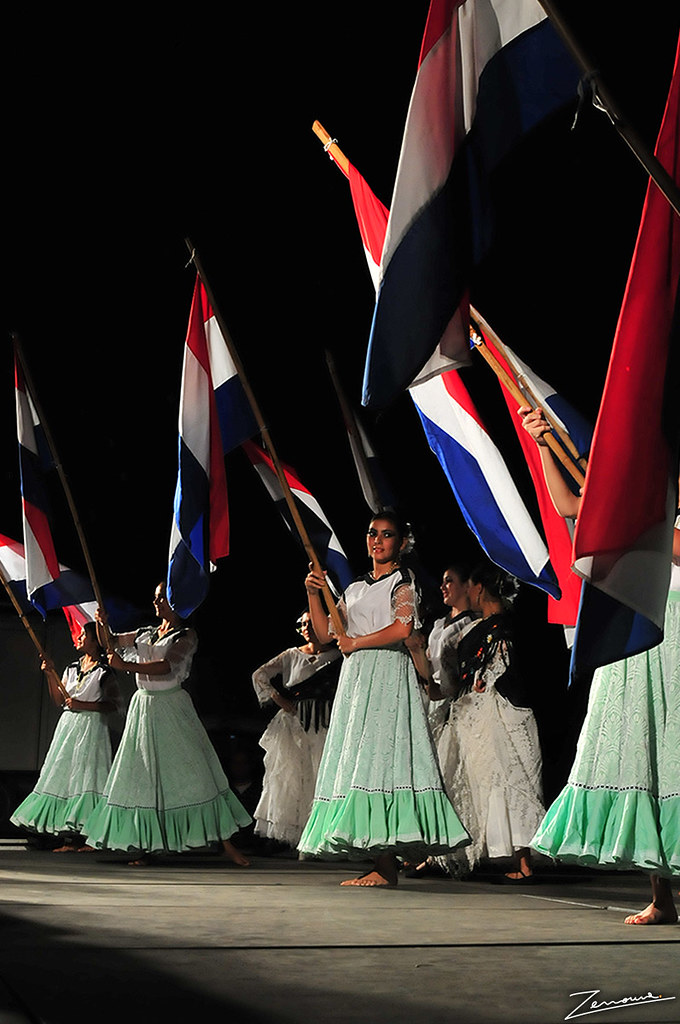
Afro-Paraguayans
History
There is little accurate information on the arrival of Africans in colonial Paraguay, beyond the
indisputable predominance of the Spanish port of Buenos Aires, as well as the ongoing contraband trade with neighboring Brazil. The first African slaves arrived the Paraguay in 1556. The most of the slaves were from Nigerian (Yoruba) and Angolan (Kongo) origin, but the Sudamericans elsewhere were obtained from. Thus, according to Argentine historian José Ignacio Telesca, the slaves that entered legally came from the esclavostas ports of Buenos Aires, Montevideo and Córdoba, while that those that entered of illegally way came from Brazil.
Thus, the Spanish explorer Pedro de Mendoza - reached the Rio de Plata in the 16th century and appointed viceroy of it - brought enslaved Africans to Paraguay to settle them in that place. According the aforementioned Telesca, more than 4% of the population were slaves in colonial times, keeping the same percentage in the 19th century after independence. However, according the Kamba Cuá "Afro Paraguayan Association", in 1782, the black population represented 11.2 percent of the total population of the then Province of Paraguay.
This population was continued to increase, as already in 1811, according Telesca, half of the Paraguayan population was of African descent, whether slave or free. So, several towns like Aregua, Emboscada (in English: "Ambush"), and Guarambare were established as black communities.
Also, with the arrived of Artigas' also arrived, curiously, people of Kamba ethnic, a Kenyan ethnic group, from Uruguay, who settled in Paraguay in the 1820s. They arrived in a regiment of 250 spearmen, men and women, who accompanied to General Jose Gervasio Artigas, the revolutionary leader of the now Uruguay, in his exile in Paraguay.
According to the few available colonial documents, it appears that the arrival of African-born captives (known as bozales `untamed’ by slave dealers) dropped off sharply after the end of the 17th century (Cooney 1995). The Swiss travelers Rengger and Lompchamp (1828), describing a voyage to Paraguay in 1825, noted that there were few Blacks in Paraguay, either enslaved or free, and that the majority of Black Paraguayans had been born in the colonies (Boccia Romañach 2005: 80).
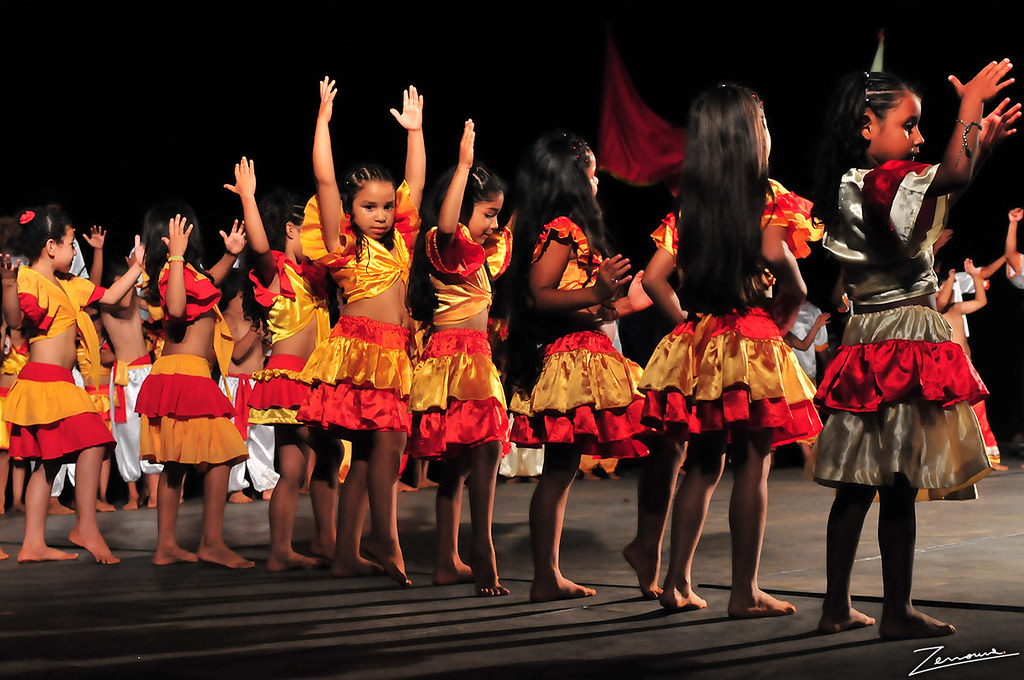
Afro-Paraguayan Kamba Kue girls` dancing group
Pastor Benítez (1955:81) attributes the minimal presence of Africans in colonial Paraguay to the absence of large-scale mining plantation agriculture: “La esclavitud era más bien casera; los siervos adoptaban el apellido del dueño. Las paraguayas prefieren amamantar al hijo, antes de confiarlo al aya negra” [Slavery was mainly domestic; servants took the surname of their owner. Paraguayan women preferred to nurse their own children, rather than entrusting them to Black nursemaids]. These observations notwithstanding, accounts of bozal (African-born) maroons in recur in Paraguay well into the 19th century; there are even accounts of uprisings in some villages (Argüello Martínez 1999: 67).
Despite the consistent historical documentation, by the beginning of the 20th century the Afro-
Paraguayan population had shrunk to the point where most Paraguayans sincerely held the opinion that the country had no Black residents. Thus for example the Paraguayan historian indirectly hinted at the lack of a Black population in Paraguay in his description of a trip to Lima, Peru in 1912 to attend a conference of educators: “El bajo pueblo ofrece idénticas analogías con la nuestra. Hay, sin embargo, en sus filas elementos exóticos, que no existen en nuestro país. Chinos y negros” [the lower classes offer identical analogies to ours; there are, however, exotic elements in their ranks: Chinese and Blacks] (Stefanich 1914: 88).
Around 1970 the late African-American historian Leslie Rout declared that “As far as most citizens in the capital city are concerned, the total physical assimilation of the Afro-Paraguayan has already
occurred” (Rout 1976:208). Rout had seen some Black residents near the river in Asuncion, but
they fled when Rout called out to him; Rout imagined that they considered him to be a Brazilian.
Andrews (2004:60), in speaking of Paraguay, cites Montaño (1997:210-10) in briefly referring to
the communities of Laurelty and Camba Cua, considered as exogenous communities not
originally arising in colonial Paraguay.
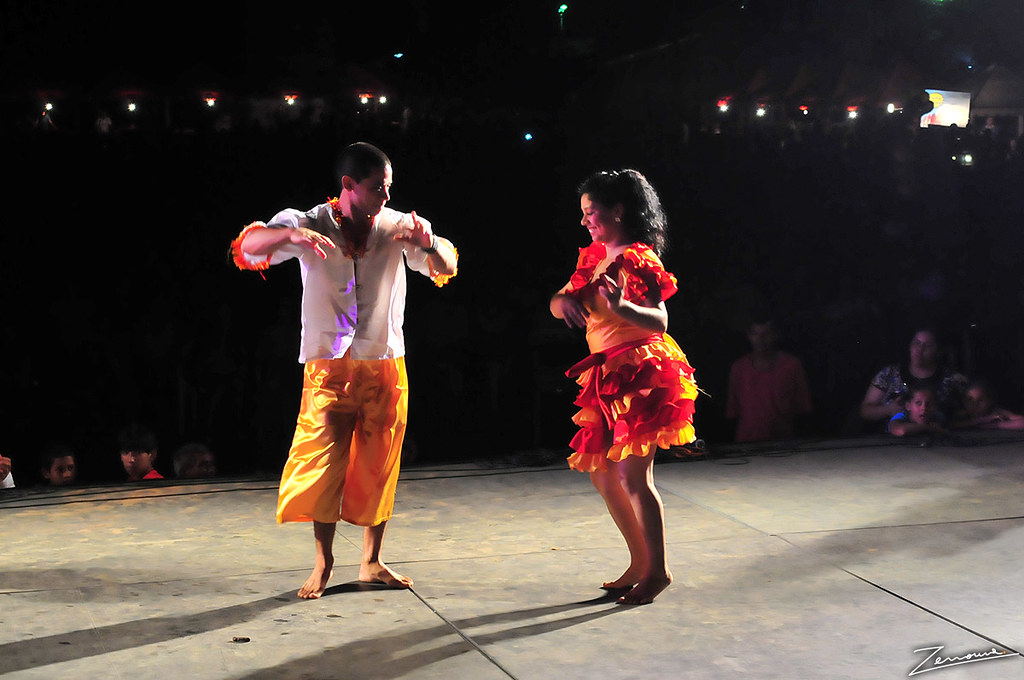
Contemporary Afro-Paraguayan Activism: The 2007 Census
In the first decade of the 21st century the notion that Paraguay has no Black population still
persists, despite the widely acclaimed Afro-Paraguayan dance group Ballet Kamba Cuá, which
gives performances across the country and in neighboring countries, and whose celebration of St.
Balthasar on January 6 attracts spectators from around the nation.
In order to combat the official policy of invisibility, a group of Afro-Paraguayan activists, headed by the director of the Ballet Kamba Cuá, Lázaro Medina, and Kamba Cuá cultural development leader José Carlos Medina organized a census of Paraguayan Afro-descendents in 2007, focusing on three communities with an acknowledged Afro-Hispanic population: Camba Cua, just outside of greater Asuncion; Kamba Kokué, on the outskirts of Paraguarí, and the city of Emboscada (AAPKC 2008). The census was supported by the Interamerican Foundation of the United States and by Mundo Afro from Uruguay. The census, which was formally presented to and accepted by the Paraguayan government and representatives of the United Nations in Asuncion, contained the following results: in Camba Cua 418 residents were included; en Kamba Kokué some 385 Afro-descendants, and in Emboscada 2686 in the urban area and another 4524 in the surrounding rural zone, for a total of 8.013 acknowledged Afro-Paraguayans.
This figure is obviously incomplete, being only a fraction of the total Afro-descendant population in Paraguay, although probably much closer to reality than the figure of 156,000 suggested by Oviedo (1992). The census did not reach all potential residents, especially in Emboscada; some individuals approached by the census takers preferred to not identify as Afrodescendents; moreover, there are other nuclei of Afro-descendant Paraguayans scattered throughout the country that have not yet been included in any reckoning. At this point it is impossible to estimate the total number of Afro-Paraguayans, but Lázaro Medina feels that the figure of around 8000 presented in the 2007 census could easily be doubled. The present study focuses on the three communities identified in the Afro-Paraguayan census, with the addition of the small enclave of Laurelty, close to Camba Cua and descending from the same original
population. If any discernible cultural and linguistic elements harking back to an Afro-colonial
past are to be found in contemporary Paraguay, they are most likely to be present in self-identified
Afro-descendant communities.

Los niños realizan bailes con sus respectivas compañeras de elenco, evocando viejas danzas africanas para buscar pareja. (The children performed dances with their cast partners, evoking ancient African dances to find a mate.)
San Agustín de la Emboscada: Town of Free Blacks: Emboscada (in Spanish: "Ambush"), a city that now has about 14,000 inhabitants, was founded in 1740 under the name of "Emboscada de Pardos libres "(Free Pardos ambush), because it was a point of frequent ambushes and because early settlers were 500 brown (black and mestizos) freedmen.
Beginning at the turn of the 17th century several villages comprised of free and enslaved Black
people were established by colonial officials, usually with an eye to fortifying remote areas that
were subject to attacks by hostile indigenous groups.
The first Black Paraguayan community Tabapy (today named Roque González de Santa Cruz) was founded in 1653 (Silva 2005: 36; Williams 1977). As a side note, in 1813 some forty Black and mulatto men were forcibly extracted from Tabapy and sent to the northern border of Paraguay to form the fortified community of Tevegó (Williams 1971; Viola 1986:142-156). This experimental community was short-lived, and did not survive past the devasting Triple Alliance War of 1864-1870.
Other Black villages founded during the colonial period were Areguá and Guarambaré. Today, few
distinguishable Afro-descendants are found in Tabapy, Areguá, and Guarambaré, and there is no
community sense of an Afro-colonial past, although the Kamba Cuá activists are beginning
outreach activities in these towns. Around 1740 (proposed dates range from 1740 to 1744), the
town of San Agustín de la Emboscada was founded, the result of constant attacks by the hostile
Mbayá.
A detachment of free Blacks and pardos (mixed-race or mulattoes was moved from Tabapy to
Emboscada, while other Black residents were sent by the religious orders based in Asuncion. It is
widely believed that Blacks and mulattoes resettled in Emboscada received some kind of conditional freedom by means of official decrees or amparos, provided that they participate
actively in military defense operations. This has given rise to the popular designation of
Emboscada as the “Town of free Blacks” (Pueblo de Pardos Libres), despite the fact that many
of the original settlers were still enslaved (Blujaki 1980, Granda 1983). Azara (1904: 47-49, 61-
62, 69), in a report dated 1790 offered descriptions of the Black and mulatto populations in
Emboscada, Areguá, and Tabapy, all of which were still considerable in the late 18th century.
Today, Emboscada is a modern and well-groomed city of some 13,5000 inhabitants, according to
the 2002 census. Although the 2007 Afro-Paraguayan census reported that some 58% of the
population of Emboscada is of Afro-colonial origin, there is little collective awareness of Afro-descendency, except for occasional holiday celebrations. Recently, Emboscada activists have
formed the Misión de Afro-descendientes de Emboscada, loosely tied to the town’s municipal
offices, but this group has yet to initiate the task of recovering traditions and memories among
the scattered rural sectors (for example Minas) most likely to contain Afro-Paraguayan cultural
remnants. Within the urban area of Emboscada, characterized by neatly manicured parks and
carefully maintained churches and monuments, there are no visible reminders of the founders of
the city, although occasional mixed-race phenotypes can be seen. Since the last African-born
bozales would have disappeared from this region more than 250 years ago, it is not surprising
that no traces of any earlier Afro-Hispanic language or ethnolinguistic traits are to be found in
contemporary Emboscadeño Spanish. As in other Paraguayan cities, proficiency in Spanish (as
opposed to Guarani) is directly proportional to the level of formal education and to contacts with Spanish-speaking sectors of the population.
The Afro-Paraguayan Community of Camba Cua: This city is in the Paraguarí Department, also was founded by black communities, having there ranches of slaves of the religious missionaries of the Catholic Society of Jesus, better known as the Jesuit order. Also towns or villages as Aregua, Emboscada, and Guarambaré were established as black communities.
The most significant Black presence in Paraguay derives not from captives formerly held in the
Spanish colony, but rather from a group of free Black soldiers who arrived in 1820. In that year
the Uruguayan general José Gervasio Artigas, following numerous defeats in his homeland, went
into exile in Paraguay, where he received political asylum from the country’s first president, Dr.
Gaspar Rodríguez de Francia.
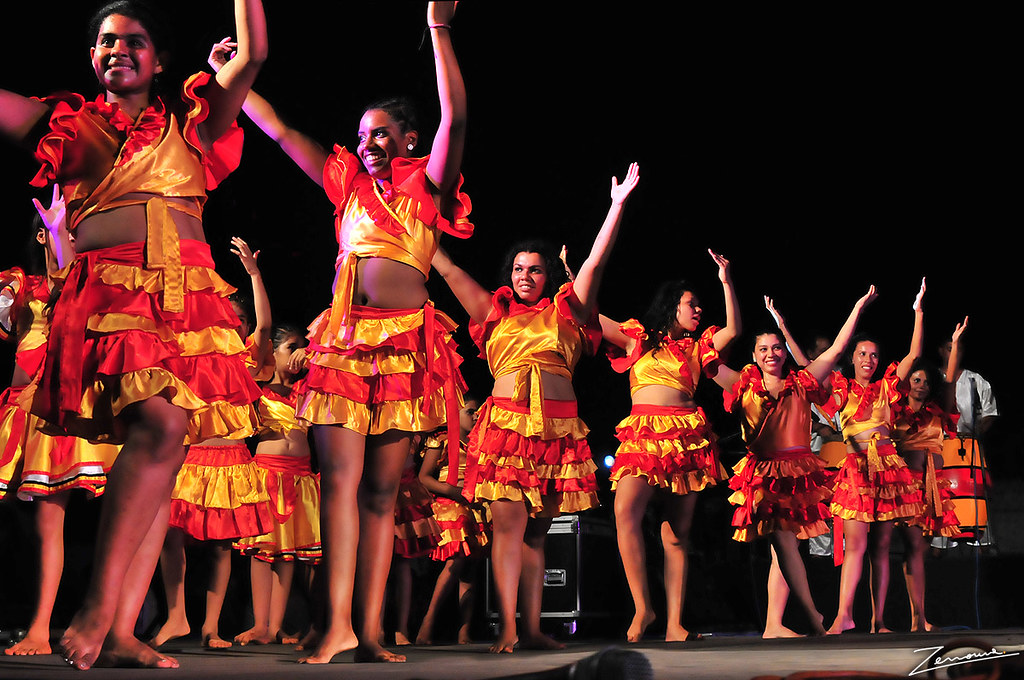
Artigas was accompanied by some 250 Black lancers (accounts vary as to the precise number), not surprising in view of the key role played by Black soldiers in Uruguay and Argentina in the many civil wars that erupted in the decades following independence. Francia—who had already proclaimed himself supreme dictator for life— evidently had second thoughts about a powerful and popular political leader establishing himself in the nation’s capital, and he sent Artigas into internal exile in distant Curuguatí, where the Uruguayan leader spent most of the rest of his life. The Black soldiers were resettled in at least two areas some 15 km. to the east of Asunción, Laurelty and what became known as Campamento Loma(s), then Lomas Campamento, and ultimately Camba Cua.
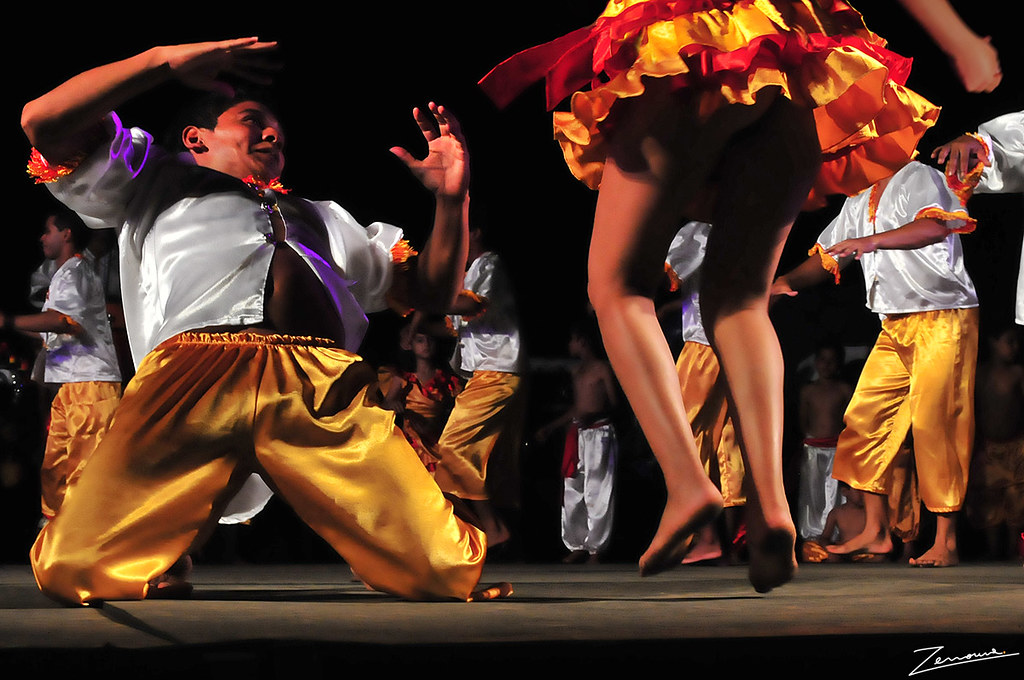
Each Black family was given land, a team of oxen, and seeds to plant, and for more than a
century and a half these tiny settlements retained a distinctly Afro-Hispanic character. Lomas
Campamento (still the “official” name of this community) became known by the Guaraní term
Camba Cua, combining an originally derisive term for Black people, camba, and the word cua,
meaning cave or hideout. The original land grant to the residents of Camba Cua was some 100
hectares. In 1940 the dictatorship of General Higinio Morínigo snatched half of the land. In
1967, at the height of the Stroessner dictatorship, soldiers suddenly cordoned off most of the
remaining land with barbed wire, with the intent of turning over this rich farmland, now part of
greater urban Asunción and bordering on the lands of a major university, to private owners
(Machado 2000, Montaño 1997:201-210; Carvalho Neto 1971:29-130, Cooney 1995).
Theresidents resisted as best they could, sending the men into hiding for fear of being killed, while
the women, armed only with sticks and machetes, tore down the fences and attempted to hold
back the soldiers and police. The latter prevailed in short order and the community was stripped
of all but seven hectares. In recent years the community has been able to recover three more
hectares, but although the Paraguayan government acknowledges the resident’s putative rights to
more land, the law requires that the land originally taken by force and coercion be paid for at
current fair market prices, estimated to be several million US dollars and beyond the wildest
dreams of the settlement’s poor residents. After losing more than 90% of their original land, the
former farmers were forced to seek alternative employment. Many of the women found work as
maids in Asunción, while those men who could find work labored as masons and carpenters.
There is considerable prejudice against visibly Black people, and consequently unemployment
and underemployment is high in the community.
Currently all that remains of Camba Cua is a long narrow strip of land along a dirt road that branches off a major artery linking Asunción and towns to the east, the Avenida Mariscal López. The dirt road is bordered on one side by the Hospital Materno Infantil, for women and children, and further along by lands belonging to the college of agriculture of the national university. On the other side the community is hemmed in by a housing development, so that Camba Cua is effectively a narrow string of houses along a winding dirt road some 1.5 km. long. The 2007 Afro-Paraguayan census counted 418 residents in 89 households, reaching nearly every community member. The community now has an elementary school, but many older residents are functionally illiterate.
Of the rich drumming and dancing traditions of Afro-Uruguayan and earlier Afro-Argentine
communities little survived the march to Paraguay in the 19th century. Afro-Paraguayans in
Camba Cua and Laurelty have always celebrated the feast of San Baltasar on January 6 with
dancing and drumming, but with only a few dancers and drummers carrying on the tradition
across generations. Ruiz Rivas de Domínguez (1974:2521-3) describes the formerly popular
galopa marimba dance with drum accompaniment; the term marimba does not refer to the
xylophone-like instrument but rather to an African drum, which accompanies the galopa. In
recent decades the annual San Baltasar celebration in Camba Cua has become a regional and
even national tourist attraction, covered extensively in the press, the subject of short television
documentaries and occasional recordings.
The Ballet Folklórico Kamba Cuá has just finished a commercially produced video DVD of
traditional dancing and drumming, and YouTube contains various video clips dealing with
Camba Cua. Hundreds of visitors show up at the tiny Camba Cua chapel, in crowds that
sometimes include members of the diplomatic corps and other resident and visiting dignitaries.
This activity has given considerable publicity to the Camba Cua community and has resulted in
generally favorable press coverage. Although there have always been traditional drummers in
the community—Santiago Medina (b. 1920), who learned from his own father, is the oldest
surviving drummer—but in recent decades the Afro-Paraguayan community has received an
infusion of cultural assistance from Afro-Uruguayan groups, most notably the Montevideo-based
Mundo Afro.
The latter group has contributed Afro-Uruguayan tamboriles, elongated drums similar to the Afro-Cuban congas or tumbadoras, to complement the rounder drums previously used by Afro-Paraguayans. The Ballet Folklórico Kamba Cuá has toured extensively, including in Uruguay and at international Afro-Latin American events, and there is clearly some syncretism and borrowing in their contemporary interpretation of drum patterns claimed to be purely traditional.
The success of the dance group has given impetus to the sister Organización Kamba Cuá, which by means of local activism as well as contact with international Afrodiasporic and human rights organizations is fighting for the return of the lands seized by the Stroessner government as well as official recognition as an ethnic community. As has occurred in Chile, Bolivia, and even in Peru, the cultural identity as afrodescendientes is a recent phenomenon in a country where possessing visible African traits has always been considered a social liability. Despite the popular acclaim of the Ballet Folklórico Kamba Cuá, the community remains marginalized and outside the pale of proactive government assistance.

The Other “Artigas-Cué”: The Afro-descendents of Laurelty
The historical record is generally clear as regards the arrival of Artigas and his Black soldiers
(known as “Artiguas-Cué”) and their subsequent redeployment in at least two areas near
Asuncion, known as Campamento Lomas (modern Camba Cua) and Laurelty. Despite this fact,
and possibly due to the recent name-recognition afforded to Camba Cua, there has arisen a
considerable confusion as to the nature and identity of the Uruguayan-derived Afro-Paraguayan
population. While some more recent accounts explicit acknowledge the existence of two
separate communities, other descriptions mention only a single community, while still others
assert that Lomas Campamento/Camba Cua and Laurelty are alternative names for one and the
same community.
The Afro-Uruguayan historian Montaño (1997:204) quotes a personal testimony from the Paraguayan historian Juan Stefanich, who in turn indicated that Artigas’ soldiers were given “un terreno llano muy apto para la agricultura situado a dos leguas de la ciudad en un lugar llamado Laurelty” [a flat piece of land well suited for agriculture and situated two leagues from Asuncion, in a place called Laurelty] Montaño notes that Laurelty “conserva aún ese nombre y allí siguen viviendo los descendientes de los soldados artiguistas, todos morenos” [it still retains this name and the descendents of Artigas’ soldiers, all Black, still live there].
Montaño goes on to say that Artigas’ soldiers were also resettled in “el otro lugar [...] fue en el
distrito de Fernando de la Mora [...] Esta comunidad se dio en llamar Loma Campamento o
Cambá Cuá [...] Es aquí donde hoy siguen viviendo los descendientes de aquellos negros y
negras que acompañaron a Artigas” [the other place was in the district of Fernando de la Mora
... this community became known as Loma Campamento or Camba Cua. It is here that the
descendants of those Black people that accompanied Artigas continue to live]. Addressing the
confusion regarding the names, Montaño (1997:204) observes that “El que sean dos las
denominaciones que han superado el paso del tiempo, es un motivo elocuente de que se piense
en la existencia de dos poblaciones” [the fact that two names have survived the test of time
provides a strong motive for believing in the existence of two communities], and cites a personal
communication from Lázaro Medina in 1996 to the effect that both communities continue to
exist.
Medina, quotes that activist as having affirmed that “Our ancestors, the honor guard for General Jose Gervasio Artigas, accompanied the General to Paraguay while he was seeking political asylum from Uruguay [...] the dictator of Paraguay at the time, Gaspar Rodriguez de Francia, who had granted them asylum, dispersed them into three groups widely separated from each other. Sergeant Ansina remained with General Artigas in Caraguatay.
A second group was sent to what is called Laurelty today, and our ancestors were sent to Lomas Campamento, which used to be within the city jurisdiction of San Lorenzo and is now within the city of Fernando de la Mora.” Andrews (2004:60) refers indirectly to two Afro-Paraguayan communities descended from Artigas’ soldiers: ““As Artigas went down in defeat, his Black troops formed the loyal hard core of his forces and followed him into permanent exile in Paraguay, where they settled in two Afro-Uruguayan towns outside Asunción that still exist to the present.”
Bejarano (1960:63) speaks of “una imagen del SANTO REY Baltazar, a quien un año festejaban en Campamento Loma o Kambakuá, y otro año en Laurelty, compañías próximas habitadas por sus familias, descendientes de los negros que acompañaron a Artigas” [an image of the Holy King Balthasar, which is celebrated every other year in Campamento Loma or Kambakua and Laurelty]. He goes on to say (p. 64): “Tanto los de Laurelty (pasando San Lorenzo), como los de Campamento Loma (al norte del Colegio Nacional de Agronomía Mariscal Estigarribia), se esfuerzan en hacer fiestas mejores que los contrincantes” [both the people from Laurelty (past San Lorenzo) and those from Campamento Loma (to the north of the Mariscal Estigarribia National Agronomy School) make great efforts to put on a better festival than their competitors]. Ruiz Rivas de Domínguez (1974:251), who interviewed Catalina and Eulalia Medina in 1954, mentions
Campamento Loma (Cambacua) and Laurelty as separate communities: “Un pequeño grupo de
familias negras se ubicó en dos compañías de la ciudad de San Lorenzo, denominadas
Campamento Loma o Cambacuá (cueva de negros) y Laurelty” [a small group of Black families
was settled in two sectors of the city of San Lorenzo, known as Campamento Loma or
Cambacuá, and Laurelty]. Obliquely suggesting a reason for the ambiguity surrounding the two
communities, Boettner (1956:192) explains that “Los negros de Artigas [...] fueron ubicados
cerca de San Lorenzo.
Hoy persisten dos comunidades llamadas Loma Campamento y Laurelty. No pasan de pocas
familias. El pueblo designa esos sitios como CAMBACUÁ [...]” [the Blacks who came with
Artigas ... were relocated near San Lorenzo. Two communities exist to this day, named Loma
Campamento and Laurelty. They have only a few families. People refer to these sites as
Cambacuá].
Despite such clear indications, several studies refer only to a single Artigas-derived Afro-
Paraguayan community, usually Laurelty (although Rodríguez 2001 and Machado 2000 only
mention Camba Cuá). Rout (1976:208) only mentions a single Afro-Paraguayan community,
Laurelty “which was started in 1820 by fifty Black and mulatto followers of the vanquished
Uruguayan patriot, José Artigas.” Rout’s visit to Laurelty in the 1960’s convinced him that “the
time of the disappearance of the last Black person in the settlement cannot be far off.”
The distinguished Afro-Hispanic linguistic scholar Granda (1983). P. 231, nota 1), states that “En el
municipio de San Lorenzo existe otro núcleo de población negra, Laurelty. Pero su origen es
exógeno, ya que surgió como tal a consecuencia del asentamiento en dicha área de un grupo de
negros uruguayos que acompañó a Artigas en su destierro al Paraguay durante la dictadura del
doctor Francia” [In the municipality of San Lorenzo there is another Black community, Laurelty.
But its origins are exogeneous, since the community arose through the resettlement in this area of
a group of Black Uruguayans who accompanied Artigas into exile in Paraguay, during the
Francia dictatorship].
Granda makes reference to Carvalho Neto (1971)’s Afro-Paraguayan studies, and it is not clear whether Granda had personal knowledge beyond that gleaned from secondary sources. Since Granda had lived in Asunción at one point and had done extensive research on Paraguayan Spanish, it is reasonable to suppose that he was familiar with communities only a few km. outside of the capital city. The Paraguayan musicologist and composer Sánchez Quell (1947:189), in his description of colonial Asuncion, speaks of “la aldea de negros denominada Laurelty [...] Allí celebraban anualmente la tradicional fiesta de San Baltasar, el Rey Mago negro [...] enorme cantidad de gente iba llegando a la capilla de Laurelty, donde se veneraba la imagen de San Baltasar” [the Black village called Laurelty ... there the traditional feast day of St. Balthasar, the Black Wise King, is celebrated annually ... a great number of people would go to the Laurelty chapel, where they adored the image of St. Balthasar]. Sánchez Quell had composed (together with Mauricio Cardozo Ocampo) a musical work “San Baltasar” based on Afro-Paraguayan traditions, so he presumably had some personal knowledge of the Black communities on the outskirts of Asuncion.
Decoud (1930: 18), in a monograph about Laurelty, describes the community without reference to any other Afro-Paraguayan settlement, although his description of Laurelty appears to more accurately fit the location of Camba Cua: “distante como dos leguas de la capital, en la jurisdicción del departamento de San Lorenzo del Campo Grande, sobre la orilla de una abra o cañada que, por
un extremo, comunicaba con la calle pública que une dicho pueblo con el de Luque y, por el
otro, con el campo llamado Ñu Guazu (Campo Grande)” [about two leagues from the capital, in
the jurisdiction of the department of San Lorenzo del Campo Grande, on the edge of a ravine
which at one end connects to the public road uniting that town with Luque, and on the other end
with the open area known as Ñu Guazú `big field’].
Decoud indirectly suggests that the name Campamento (currently applied to Camba Cua) in fact
pertained to Laurelty; according to his analysis, Guaraní speakers who saw Blacks for the first
time exclaimed ¡Cambá, memetéro chamento! `they are really black!’ According to Decoud
(1930: 16): “estos vocablos nativos, con el transcurso del tiempo, fueron transformándose hasta
quedar definitivamente castellanizado, bajo el nombre de “Campamento”, el cual conserva hasta
hoy, existiendo siempre algunos de los descendientes que dieron origen a tal denominación, que
muchos aún están radicados en las tierras que fueron de sus remotos antepasados [...]” [these
native words, with the passing of time, became transformed into Spanish with the name
“Campamento,” which is used to to this day, since some of the descendents of those who gave
rise to this name continue to live there]. Decoud (1930:13) also describes the founding of
Laurelty in 1843 “sobre el camino entre San Lorenzo y Luque” [along the road between San
Lorenzo and Luque], which also corresponds to the location of Lomas Campamento/Camba Cua.
In his literary vignettes, Galeano (1984: 149-150) only makes reference to “Campamento
Laurelty” in describing the arrival of Artigas’ black soldiers in Paraguay.
To add to the confusion, several prominent researchers have referred to Laurelty and Lomas
Campamento/Camba Cua as being alternative names for a single community. The Brazilian
anthropologist Carvalho Neto (1971: 109), referring to data collected in Paraguay in 1951, states
that “El actual negro paraguayo vive en colonias de negros, geográficamente distantes entre sí
[...] tuvimos referencias de las siguientes: Campamento o Campamento Loma o también
Campamento Laurelty, Emboscada, Camba-Cuá, Lavretá, Fernando de Lamora y San Baltasar
[...]Campamento Loma o Laurelty es aún hoy aquel mismo sitio donado por el dictador Francia a
algunos de los negros orientales que acompañaron a Artigas al Paraguay en 1820” [The
contemporary black Paraguayan lives in Black settlements, geographically separated from one
another [...] we heard about Campamento or Campamento Lomas or also Campamento Laurelty,
Emboscada, Camba Cua, Lavretá, Fernando de La Mora and San Baltasar [...] Campamento
Loma or Laurelty is even today the same site donated by the dictator Francia to some of the
Black Uruguayans who accompanied Artigas to Paraguay in 1820].
The Afro-Uruguayan scholar Pereda Valdés (1964: 6) assserted that “En el Paraguay, a dos leguas de la ciudad de Asunción existe un lugar llamado Laurelty también denominado Cambá Cuá ... donde habita desde hace muchos años un núcleo de descendientes de africanos que mantienen sus tradiciones” [in Paraguay, two leagues outside of Asuncion there is a place called Laurelty and also called Camba Cua ... inhabited for many years by a group of African descendents who maintain their traditions]. A number of didactic web sites also maintain the ambiguity surrounding Laurelty.
One site devoted to the Paraguayan polkavi asserts that “ [...] algunas comunidades como
Kambacuá en Laurelty, situada en el límite de Fernando de la Mora y San Lorenzo, han
reivindicado su ascendencia negra con el cultivo de su música, sus danzas y sus tradiciones”
[some communities like Kamba Cuá in Laurelty, located on the border of Fernando de la Mora
and San Lorenzo, have acknowledged their African ancestry through cultivating their music,
dance, and traditions].
It is precisely Camba Cua that is located in Fernando de la Mora, while across the street only a
few meters away the municipality of San Lorenzo begins. An official web site of the nearby city
of Luquevii claims that “Se los llama Kamba Kua. ... El gueto de gente de color ubicado en
Laurelty, Luque. Gente de origen humilde, cuya presencia en el país arranca del tiempo en que el
general uruguayo Artigas busco refugio en el país, allá por 1820” [they are called Kamba Cuá ..
this group of colored people located in Laurelty, Luque, people of humble origins, whose
presence in this country goes back to the times in which the Uruguayan general Artigas sought
refuge in the country in 1820].
While it is not surprising that writers from outside of Paraguay might confuse the names and
even the existence of the two Black communities arising from Artigas’ exile from Uruguay, it is
not clear why such confusion should have recurred so frequently among Paraguayans. It is
possible that the use of Camba Cua to refer to any small Black enclave may have caused some
ambiguity, but the failure to distinguish names and places as distinct as Campamento Loma and
Laurelty is more likely attributable to racist indifference in a society supremely uninterested in
accurate details about its tiny Afro-descendent population. After sorting through the tangle of
contradictory statements and after receiving ambiguous or vague responses from several
Paraguayan sources, I returned to Camba Cua in 2008, and accompanied by Lázaro Medina,
director of the Ballet Folklórico Kamba Cuá, conducted field research in Laurelty.
Today Laurelty is a marginal sector of the sprawling city of Luque, and located only a few kilometers from Camba Cua. Like Camba Cua, Laurelty consists of several blocks of semi-rural residences, located less than one kilometer from a main road that traverses Luque. Ordinarily ignored by other residents of Luque and neighboring communities, Laurelty made headlines throughout South America in early 2008, due to a serious outbreak of yellow fever, surprising in such an urbanized area, and indicative of the marginality and poor sanitary conditions of this sector. The Santo Rey (Holy King) chapel of St. Balthasar sits in the middle of the community, recently
rebuilt on the ruins of an older chapel. As in Camba Cua, residents of Laurelty celebrate the feast
of St. Balthasar on January 6, and older people recall a time when drumming and dancing were
part of the celebration. At the present time, drumming is rare on the feast day, but some younger
community members are in contact with Camba Cua activists in an attempt to revive the cultural
links between the two communities that flourished in earlier generations. Few people in Laurelty
exhibit Afro-descendent phenotypes, and even fewer actively identify themselves as Afro-descendents, although the growing popularity of the Ballet Folklorico Kamba Cuá and the annual festivities in that community are piquing the interest of some Laurelty residents.
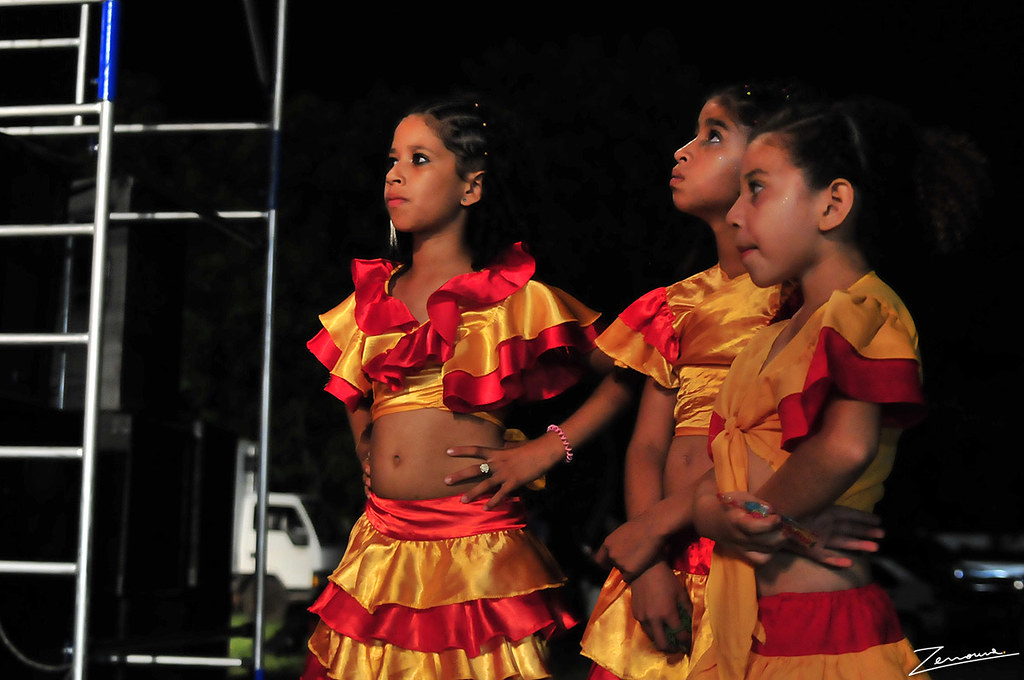
The Afro-Paraguayans of Kamba Kokué
The existence of Afro-Paraguayans in Emboscada was known to other Paraguayans even in
recent times, while the communities of Lomas Campamento/Camba Cua and Laurelty had been
mentioned by historians (in Paraguay and Uruguay) and musicologists, although largely going
unnoticed in the remainder of the national population. As the Kamba Cuá activists began
preparations for the Afro-descendent census, a third historically Black community not previously
mentioned in historical accounts came to light, in a marginal sector on the outskirts of the city of
Paraguarí, some 70 km. to the southeast of Asuncion. The traditional name of the community is
Kamba Kokué, which in Guaraní means `farm of the Blacks’; the official name today is Barrio
Virgen de Caacupé, although the residents themselves continue to use the older name.
The community currently consists of a few semi-rural blocks just off the main highway at the
entrance to Paraguarí; dirt roads and small homes are flanked by an old cemetery and several
fallow plots of land. The 2007 Afro-descendent census counted some 385 inhabitants in 90
households, approximately the same as Camba Cua. Older and even middle-aged residents tell
tales of discrimination, racist comments and shunning by residents of neighboring sectors of
Paraguarí, and the census takers not surprisingly discovered that not all residents willingly
identify themselves as Afro-descendents. As in the other Afro-Paraguayan communities, racially
distinctive phenotypes, while not uncommon in Kamba Kokué, are interspersed with other more
indeterminate physical traits, to the point where Kamba Kokué is no longer a visibly “Black”
neighborhood. In one corner of the community, sandwiched among several large trees, are found
two chapels, one very small and rustic, the other a larger more recent construction. The latter
building bears a brightly painted sign over the entrance reading “Oratorio Virgen del Rosario
Kamba Kokué”,viii and inside are several paintings depicting African and Afro-American figures.
Young community activists have formed the Comisión Afroamericana Kamba Kokué, and group
members participated in the Afro-descendent census and in other Afro-Paraguayan cultural
events. The oral history of Kamba Kokué is now mentioned in some of the local schools,
although no written materials have yet been prepared and the official curriculum makes no
mention of Black Paraguayans. Older residents interviewed for the present study expressed pride
in the census and in the renewed sense of community identity, even those inhabitants who do not
consider themselves to be Afro-descendents. Younger people within the Kamba Kokué sector are
increasingly proud of their heritage, while the rest of Paraguarí, including the immediately
adjacent neighborhoods, appears to have scarcely noticed the presumed Kamba Kokué cultural
revival.
To date no accurate information on the origins of Kamba Kokué’s Black community has come to
light. According to the collective memory of many older residents, the community of Kamba
Kokué has its roots in colonial history, quite probably to the slave-holding estates of religious
orders throughout Paraguay. As in the case of the Afro-Hispanic communities of highland
Ecuador’s Chota Valley, the majority of slave-holding estates in Paraguay were managed by the
Jesuits until their expulsion in the middle of the 18th century.
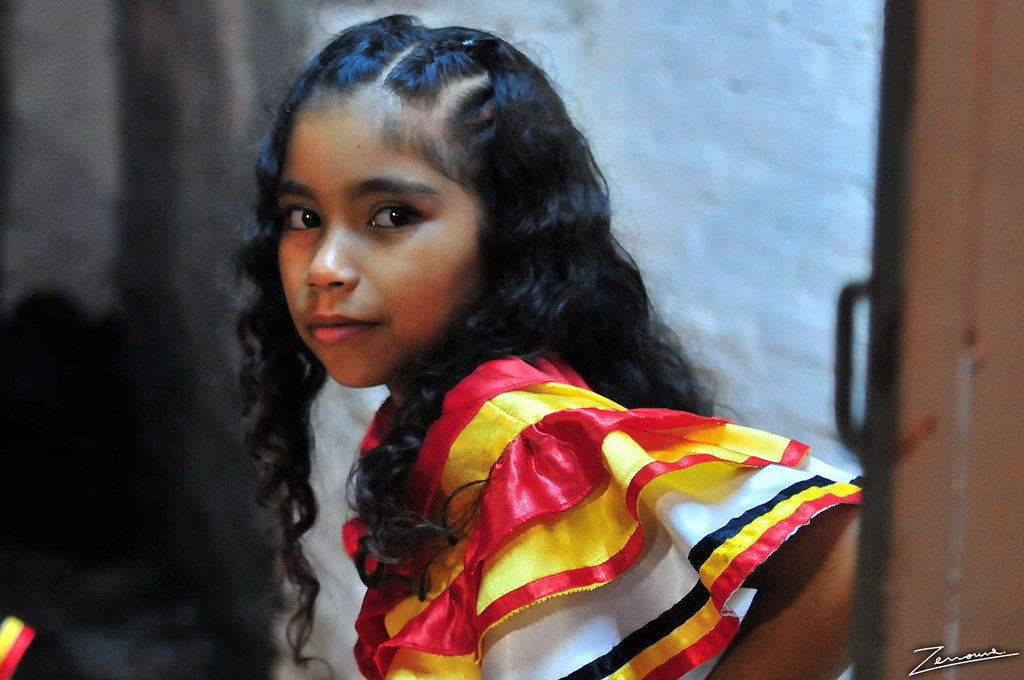
In Paraguarí, the former Jesuit estates were taken over by the Ignacian order. According to
Boccia Romañach (2004: 223; 2005: 80) and Maeder (1996), when the Jesuits were expelled,
they held 519 enslaved Blacks in Paraguarí, a number which increased through natural
reproduction in the following years. As late as 1837 there were still some 160 enslaved Blacks in
the estates surrounding Paraguarí, together with an unspecified number of free Blacks and
pardos (Boccia Romañach 2004: 224; Argüello Martínez 1999: 74). Although Kamba Kokué
was never geographically isolated from nearby Paraguarí, the status of community members as
captives and later free persons of color resulted in the social and linguistic marginalization of this
tiny ethnic enclave. According to Kamba Kokué oral traditions, the image of the Virgen del
Rosario currently placed in the large chapel was originally discovered by a Black woman during
the colonial period. The same residents tell tales of the old communal well—still in existence at
one edge of Kamba Kokué and still occasionally used for drawing drinking water—as the main
source of water for the Black community in the past.
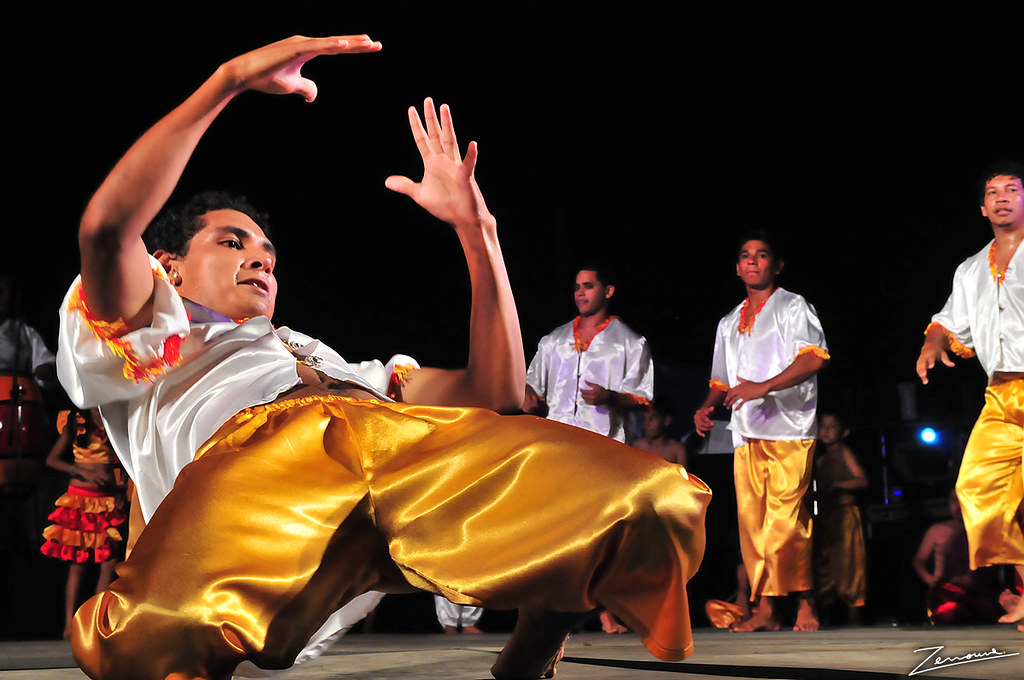
Afro-Paraguayan Kamba Kue dancing group. In this context in Paraguay has been developing the tour of a show called "Negritud de colores" (Negritude Colors) that runs in different cities. It is a show of Afro-Latin American music and dance scenes, songs, chants, and dances with rescued African roots of this continent. The Paraguayan singer Mariví Vargas and his team of musicians, drummers, and dancer from Kamba Cuá led by Lazaro Medina and offer a show that aims to make Afro-Paraguayan culture a visible part of the collective African descent.
Source: http://www.jpanafrican.com/docs/vol2no7/2.7_Afro-Paraguayan.pdf
Photo credit:http://www.cazadordeinstantes.com/2011/01/kamba-cua-2011.html
Afro-Paraguayans: Identity, Synergy, Census
Who thinks of Paraguay as home to African descendants? A recent World-Bank financed study of the country’s economic situation includes discussions of ethnic minorities ranging from the Mennonite community to citizens of Japanese ancestry, but neglects any reference to Afro-Paraguayans. The scant literature mentioning them at all invariably refers to their invisibility. Most Paraguayans would be surprised to know of the existence of communities of African descent in their midst, despite rousing displays of African-rooted dance, public celebrations of Saint Balthazar and undeniable historical references. Many African descendants themselves are unaware of their own heritage and origins.
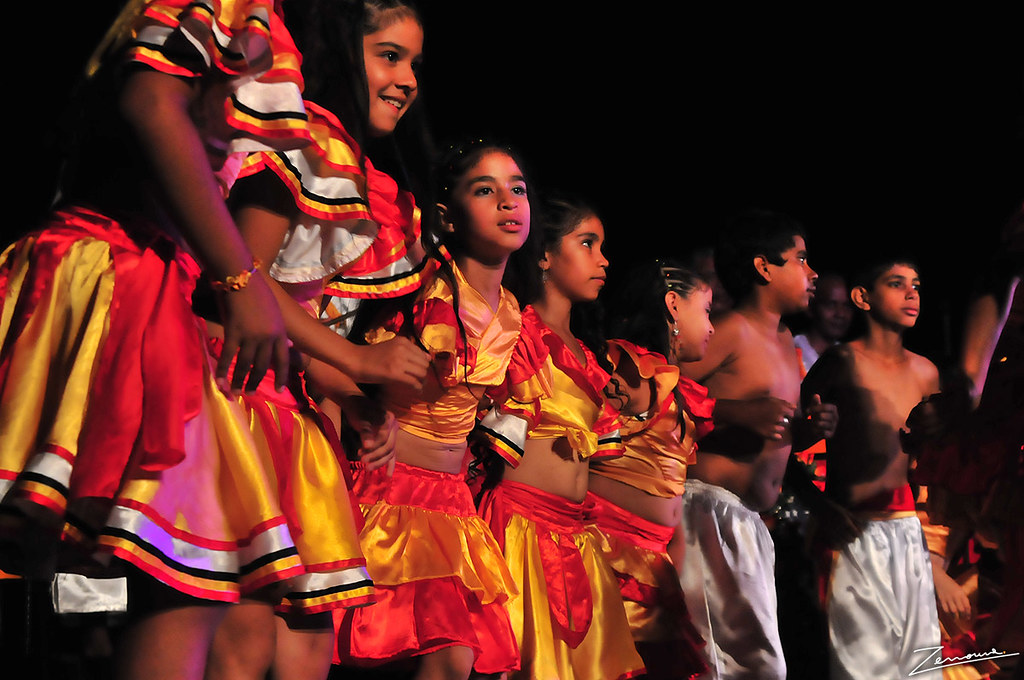
Could this be about to change? Asociación Afro Paraguaya Kamba Cua (AAPKC), a group of African descendants that has always had a strong sense of identity, recently received an IAF grant to survey conditions in three Paraguayan communities of African descent. AAPKC is in Kamba Cua, a neighborhood located 15 miles from downtown Asunción where most residents descend from the slaves and free blacks serving under General José Artigas during Uruguay’s struggle for independence from Spain. In the 1820s, these loyal troops and some family members followed Artigas into exile in Paraguay where the government gave them seeds, animals and 100 hectares of prime land to farm, which they and their descendants did for more than a century.

“In those times, my people lived well,” said José Carlos Medina, who grew up in Kamba Cua and coordinates AAPKC’s IAF-funded project. If almost everyone in this article is named Medina, it’s because they are all family. The Paraguayan government conditioned the grant of the land on an order not to socialize with the local population, so Kamba Cua residents quickly became related by marriage. Eventually though, said José Carlos Medina, they had to find spouses outside their community so recent generations boast a mixed heritage. Like most Paraguayans, people in Kamba Cua navigate effortlessly between Spanish and Guaraní.

“We planted corn, manioc, sugar cane, tobacco, watermelons, chickpeas,” recalled Eulalia Medina, José Carlos’ aunt. “Everyone had a plot.” But no one in the community had clear title to the land under cultivation, and military dictators Higinio Morínigo, in the 1940s, and Alfredo Stroessner, in 1967, transferred most of it to the government or to private parties; the national medical school now sits on a portion. Eulalia Medina, who was 12 during the Stroessner regime’s expropriation, vividly remembers the community’s resistance when soldiers arrived to physically remove the residents. They were allowed to remain on the few hectares left to Kamba Cua, but their livelihood was gone. Like so many Paraguayan women, Eulalia Medina left for Buenos Aires to support her family by working as a maid. So did José Carlos Medina’s mother whose sacrifices helped buy an attractive home and pay for her son’s university education.
Kamba Cua residents have never accepted the loss of their land. After the fall of the Strossner government in 1989, young people began to coalesce around the issue, and in 1999 they formed AAPKC. On Oct. 12, 1999, they coordinated a mass occupation of the area they considered their patrimony. The government responded with a show of force but turned over one and one-half hectares with—on Sept. 21, 2006—the all-important documents conveying title. That has raised hopes, and Kamba Cua is now suing for legal title to a larger area. “Without the land, our community will disappear,” explained José Carlos Medina. Ask him about discrimination, and he immediately points to the expropriation, but he is also worried about racial profiling, the practice of requiring photos with job applications and race-based admission to places of entertainment. A long history of official indifference, he says, is confirmed by the lack of any data on the conditions of Afro-Paraguayans. “We only just got our street paved,” he added. “We have less access, fewer opportunities.”
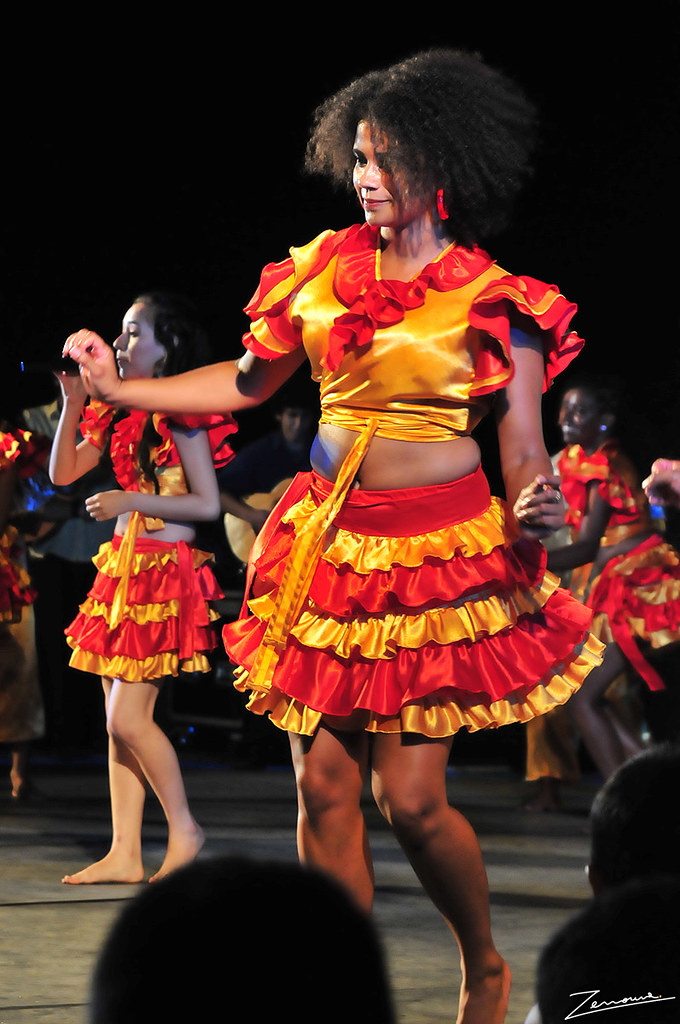
Afro-Paraguayan dancers
AAPKC is headquartered in a two-room structure that community members added on to Kamba Cua’s primary school with help from Germany’s foreign aid agency and Aleya Horn, an African-American U.S. Peace Corps volunteer. The school itself was no more than a few years old, according to Horn. It had been built by the community, with municipal support, after AAPKC persuaded the municipality of the necessity for it. The education started from scratch, adding a grade each year. “My work was successful,” said Horn, “because AAPKC was so organized. It had a mission.”
.JPG)
Los integrantes del grupo afroparaguayo con la imagen del “Rey Negro” San Baltazar
That mission has broadened to embrace the promotion of racial equality, human rights and economic development for all African descendants, who rank with the indigenous peoples as the most impoverished Paraguayans, according to a report by Minority Rights Group International of the United Kingdom. But how do you enlist support from the very people who would benefit when they have so little sense of who they are? AAPKC has started by sharing traditions preserved in Kamba Cua, which its leaders hope will rally Afro-Paraguayans to their identity, a first step in organizing. Its star attraction is the Ballet Kamba Cua, some 60-dancers strong accompanied by musicians who beat seven distinctly Afro-Paraguayan rhythms on drums crafted under the supervision of master drum maker Dionisio Medina. “Culture, identity, synergy,” ballet director and Kamba Cua president Lázaro Medina described the plan.
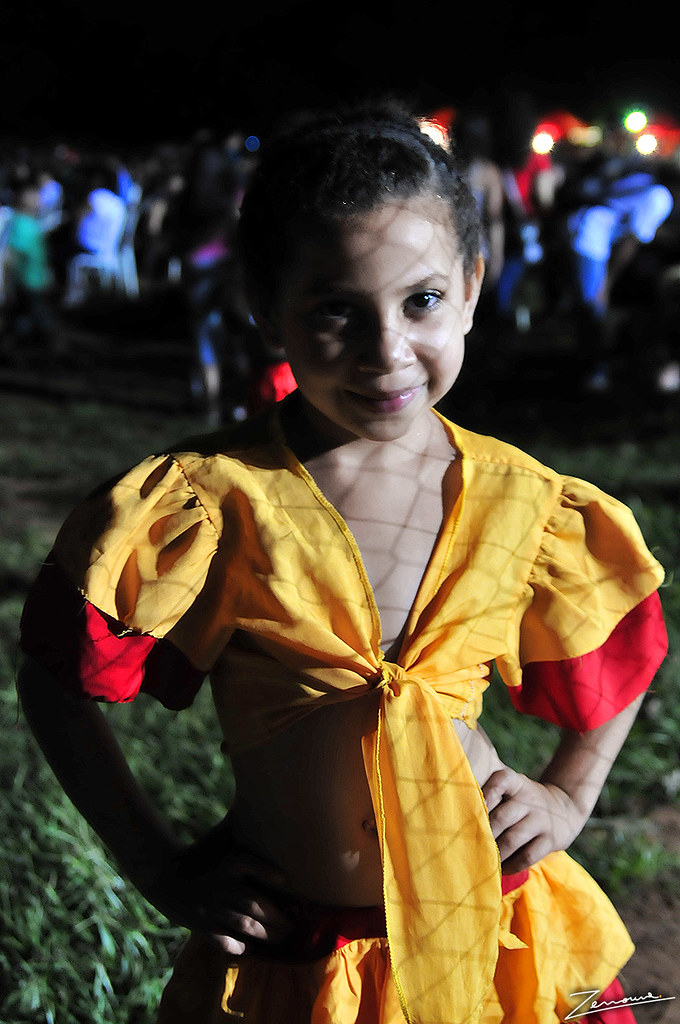
Afro-Paraguayan kid of Kamba Kue group
Through Laurence Crockett, another African-American Peace Corps volunteer, AAPKC established contact with a larger community of African descendants in Emboscada, a town some 36 kilometers from Asunción. Crockett, who now lives in New York, was quickly caught up in the enthusiasm of Patricio Zárate de la Cruz and other young Afro-Paraguayans eager to discover their roots. “They knew there was a history,” he said. “They just didn’t know where to begin. We started by interviewing older Emboscada residents and then went on to the archives.” Everyone credits Crockett for the direction he gave this research into the slaves who had built a port on the river nearby. “We discovered that our community dates from 1740, much earlier than we had been told,” said Zárate, now coordinator of the group that organized to focus on this new-found identity. The group, which will work with AAPKC on the survey, has its headquarters on the grounds of Emboscada’s primary school and several teachers are involved in its activities.
The teachers and Zárate are among the few African descendants in Emboscada who have had access to higher education. For most African descendent men there, the only option is the cantera, or quarry, where the work is hard and dangerous and the pay is often poor. According to José Carlos Medina, and to a recent article in Asunción’s ABC Digital, many pedreros die before they are 40, from -respiratory problems caused by inhaling thick dust as they smash the rocks into smaller pieces. The use of dynamite damages their hearing and causes serious, sometimes fatal accidents. Medina hopes that organizing the community will lead to safety regulations, requiring the use of masks and prohibiting smoking, and to better pay. “If the pedreros would form a cooperative and buy a car,” he added, “they would make four to five times their current income.”
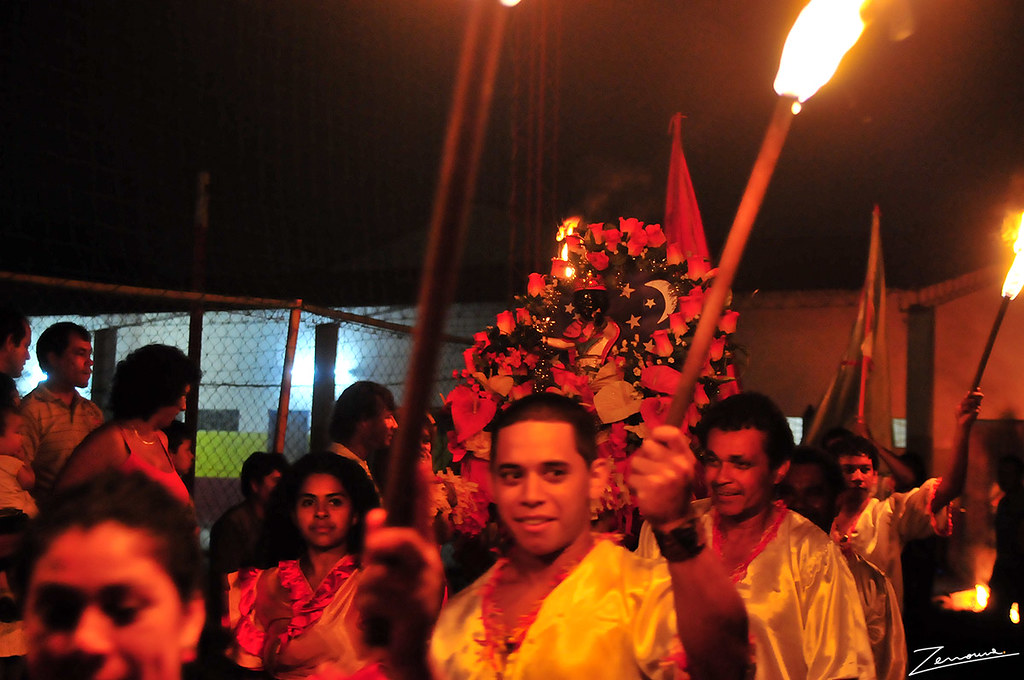
AAPKC will also survey African descendants in Paraguarí, about 60 kilometers from Asunción in the opposite direction, where Susana Arce, a teacher, heads Comisión Afro Americana Cambacaué. “We’ve been here 200 years,” she said of the community’s 50 families. “Our ancestors were slaves of the Jesuits. They built the government building and finished the church in 1862, just a few years before slavery was abolished.” Arce is concerned that local Afro-Paraguayans don’t know about their African roots, or won’t acknowledge them, and she has high expectations of the survey. “Through the census,” she said, “we are going to know who we are—how many families we have in the community, how they earn their living and their work, how many children are not in school and how to address that.”
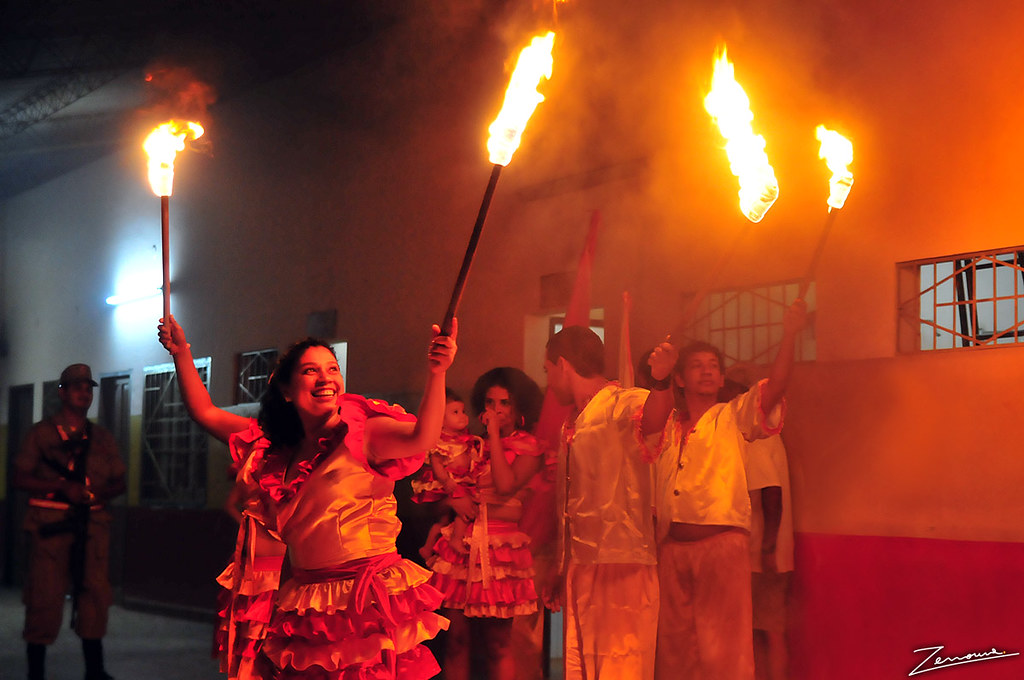
Work on the survey began in July 2006. In all three communities, residents finalized the questionnaire and learned to collect and process raw data on household composition, home ownership, housing conditions, employment, education, well-being, the use of health services, nutrition, income, and on migration, race and identity. The University of Asunción, Paraguay’s National Institute of Statistics and Organizaciones Mundo Afro of Uruguay have partnered with the communities. Horn sees the survey as vital. “One of my most upsetting experiences as a Peace Corps volunteer was listening to officials say that there was no such thing as an Afro-Paraguayan,” she said. “The data,” said José Carlos Medina, “will help Afro-Paraguayans begin a dialogue with the government on public policies and programs and on an ethnicity component in the national census. Accurate socio-economic information will be the basis for future development.”
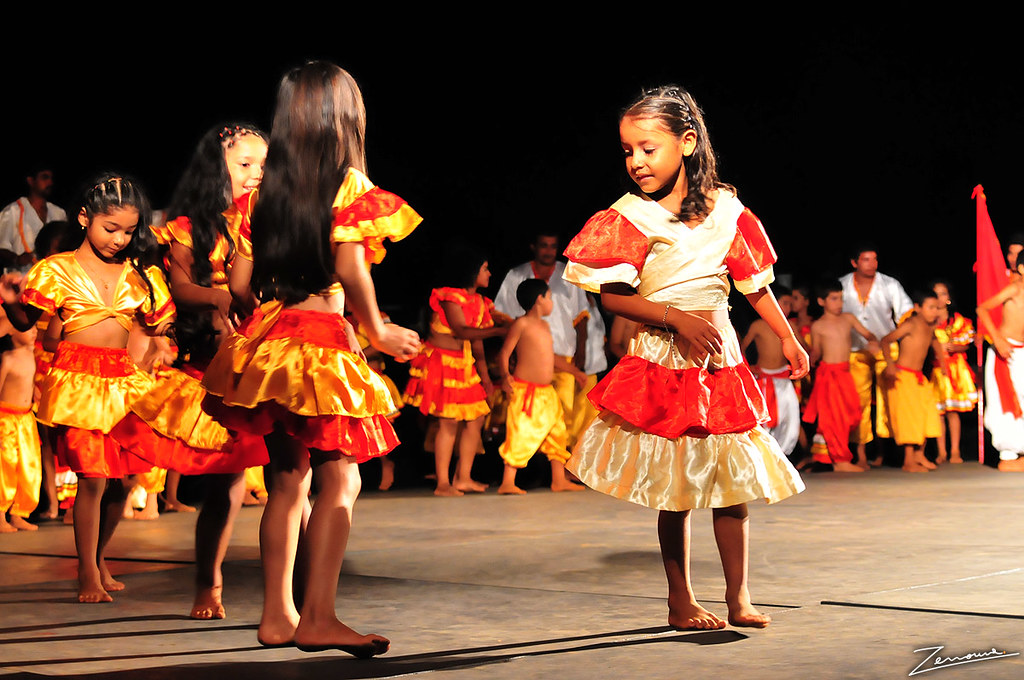











0 comments:
Post a Comment